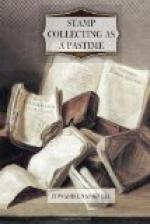But of all the portraits that have appeared upon postal issues, none probably occasioned so much trouble and fuss as that of the notorious King Bomba of Sicily. The most eminent engraver of his day—Aloisio—was commissioned to prepare an exact likeness of His Sacred Majesty. After much ministerial tribulation the portrait was approved and engraved, and to this day it is regarded as a superb piece of work. A special cancelling stamp had to be designed and put into use which defaced only the border of the stamp and left the sacred portrait untouched. During the preliminaries necessary to the production of the sacred effigy the fate of ministers and officials hung in the balance. One official was actually marked for degradation for having submitted a disfigurement which turned out to be a carelessly printed, or rough, proof impression.
Numerous stamps have been designed, especially of late years, to represent some historical event in connection with the country of issue. The United States, in 1869, in the confined space of an unusually small stamp, endeavoured to represent the landing of Columbus, and in another stamp the Declaration of Independence. In a much more recent series, stamps of an exceptionally large size were adopted to give scope for a Columbus celebration set of historical paintings, including Columbus soliciting aid of Isabella, Columbus welcomed at Barcelona, Columbus restored to favour, Columbus presenting natives, Columbus announcing his discovery, the recall of Columbus, Isabella pledging her jewels, Columbus in chains, and Columbus describing his third voyage. Greece has given us a set of stamps illustrating the Olympian Games. But collectors look with considerable suspicion upon stamps of this showy class, for too many of them have been produced with the sole object of making a profit out of their sale to collectors, and not to meet any postal requirement.
Crude productions of peculiar interest belong more to the earlier stages of the introduction of postage stamps. Local attempts at engraving in some of our own early colonial settlements were of the crudest possible description, and yet they are, because of their very crudeness, far more interesting than the finished product supplied by firms at home, for the local effort truly represented the country of its issue in the art of stamp production. The amusingly crude attempts which the engravers of Victoria have made from time to time, during the last fifty years, to give us a passable portrait of Her late Majesty Queen Victoria, have no equal for variety. The stamps of the first South African Republic, made in Germany, are very appropriate in their roughness of design and execution. For oddity of appearance the palm must be awarded to those of Asiatic origin, such, for instance, as the stamps of Afghanistan, of Kashmir, and most of the local productions of the Native States of India, marking as they do their own independent attempts to work up to European methods of intercommunication.




